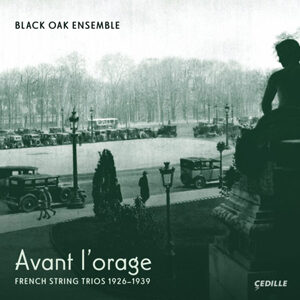Occasionally you hear a commentator use the term “accessible” to describe a musical work or style. Yet, as with other terms such as “affordable” in reference to housing, without context it is virtually meaningless: we need to know who is applying the term and to what it’s being compared. So, when I assert that most listeners will find the seven works on these two smartly programmed discs “accessible”, it is as much about what they are not than what they exhibit in style and musical substance.
For anyone at all concerned about setting forth on a journey through two hours of unfamiliar 20th century chamber works–string trios, no less!–be assured that throughout this program you will encounter nothing of the atonal, anti-melodic, thematically ambiguous, or deliberately arcane efforts that characterize many works from this same period (“Avant l’orage”, “before the storm”). Regarding the term “accessible”, you will find in each of these works not only a “way in” that’s familiar and (to most listeners) comprehensible, but music that is unfailingly captivating, thought-provoking, and challenging, all in ways that both entertain and enlighten. Now how can you do better than that?
Henri Tomasi’s Trio (1938), one of three recording world premieres on the disc, makes an excellent opener, its pleasingly assertive Prélude, an uneasy, restless Nocturne, mischievous Scherzo, and relentlessly energetic, folk-like Final drawing us in with an irresistible, festive air that also shows off the Black Oak Ensemble’s range of virtuosity, color, and style.
Jean Cras’ 1926 Trio has many highlights throughout its four substantial movements (24 minutes), but the fourth may be the most notable–a dance, whose rhythmic progression and character is anything but predictable!
Jean Françaix, successful performer and prolific composer who early on caught the attention of Ravel, dedicated his 1933 Trio to the three brothers who made up the Pasquier Trio (also the dedicatees of Tomasi’s Trio). You may never have seen a tempo designation of “Allegretto vivo” (this work’s first movement), but in their delightful, dexterous, precisely controlled moto perpetuo frenzy the Black Oak musicians leave no question as to their interpretation of the term! And has there ever been a Scherzo more deserving, or illustrative, of its name? Or played with a truer sense of joy and humor? The final Rondo is a fabulously virtuosic complex of rhythm and meter changes, and again these players nail the shifts and turns with requisite technical precision and musical flair.
If you know Robert Casadesus primarily–or exclusively–as a pianist, here’s your chance to get to know some of his scarce yet very fine work as a composer. His Trio à cordes from 1938, also dedicated to the Pasquier Trio–and also a world-premiere recording–may not be the most sophisticated or inventive work on the program, but it shows an intriguing interplay among instruments and well-developed sense of momentum by force of melodic/thematic development and strong rhythmic presence.
The third premiere recording is Gustave Samazeuilh’s 1937 Suite. Although its six movements are modeled on “the form of a Baroque dance suite”, you won’t hear anything stylistically related in the music itself. Yes, it’s very tonal, but has more in common with 19th-century Romanticism. And it’s all very lovely, originally written for piano and re-scored for, you guessed it, the Trio Pasquier. Here the Black Oak players seem to revel in the inherent opportunities for highlighting the music’s richness of timbre and singing melodies.
There are many other discoveries and delights to be found in the remaining trios by Émile Goué and Gabriel Pierné–which by now you will hopefully be looking forward to hearing for yourself. And I have to say that if I were one of the composers represented here I would feel blessed to have such advocates as the three musicians of Black Oak Ensemble: Desirée Ruhstrat (violin); Aurélien Fort Pederzoli (viola); David Cunliffe (violoncello).
This is difficult, challenging music that requires not only a comprehensive, deeply felt sense of style and prodigious technical facility, but an understanding of how to differentiate the expressive demands of a collection of pieces that are in some ways similar, but in more ways quite different, and how as an ensemble to make each stand out and stand in its own deserving space. Not only does the Black Oak Ensemble achieve this, but their effort makes you more than eager to hear the whole thing again. I’m happy to say that you’ll also learn a lot from the excellent notes by Elinor Olin. Accessible, enduring, enlightening, and highly recommended.
































